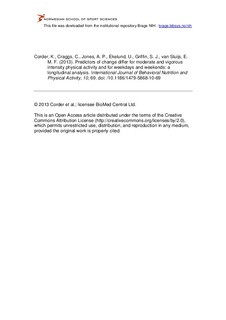| dc.contributor.author | Corder, Kirsten | |
| dc.contributor.author | Craggs, Christopher | |
| dc.contributor.author | Jones, Andrew P. | |
| dc.contributor.author | Ekelund, Ulf | |
| dc.contributor.author | Griffin, Simon J. | |
| dc.contributor.author | van Sluijs, Esther M. F. | |
| dc.date.accessioned | 2014-01-14T11:43:49Z | |
| dc.date.available | 2014-01-14T11:43:49Z | |
| dc.date.issued | 2013 | |
| dc.identifier | Seksjon for idrettsmedisinske fag / Department of Sports Medicine | |
| dc.identifier.citation | International Journal of Behavioral Nutrition and Physical Activity. 2013, 10, 69 | no_NO |
| dc.identifier.uri | http://hdl.handle.net/11250/171240 | |
| dc.description | © 2013 Corder et al.; licensee BioMed Central Ltd. | no_NO |
| dc.description.abstract | Background
Predictors of physical activity (PA) change are rarely investigated separately for different PA intensities and for weekdays/weekends. We investigated whether individual-level predictors of one-year change in objectively-measured physical activity differ for moderate PA (MPA) and vigorous PA (VPA) and for weekends and weekdays.
Methods
Accelerometer-assessed PA (mins) was obtained at baseline and +1 year (n = 875, 41.5% male, Mean ± SD baseline age: 9.8 ± 0.4 years-old). Potential predictors (n = 38) were assessed at baseline from psychological (e.g. self-efficacy), socio-cultural (e.g. parent support) and environmental domains (e.g. land use). Associations between predictors and change in MPA (2000–3999 counts/minute (cpm)) and VPA (≥4000 cpm) separately for weekdays and weekends were studied using multi-level linear regression. Analyses were adjusted for school clustering, sex and baseline PA.
Results
Weekend PA declined (MPA decline 4.6 ± 21.8 mins/day; VPA decline: 2.1 ± 20.1 mins/day; both p < 0.001) whereas weekday PA did not significantly change. Higher baseline PA and being a girl were associated with greater PA declines in all four outcomes; remaining predictors differed for MPA and VPA and/or weekdays and weekends. Family logistic support was associated with less of a decline in weekend MPA (CI 95%) 0.15 (0.05, 0.25) and VPA 0.19 (0.09, 0.29), and peer support with less of a decline in weekday MPA 0.18 (0.02, 0.34) and VPA 0.22 (0.06, 0.38).
Conclusions
Results highlight the relevance of investigating predictors of PA change separately for different PA intensities and for weekdays/weekends. In addition to continued focus on school PA promotion, more effort to target interventions during weekends, such as in the family and community appears important. Encouraging peer support to increase weekday PA and targeting parent support for weekend PA may be health promotion priorities. | no_NO |
| dc.language.iso | eng | no_NO |
| dc.publisher | BioMed Central | no_NO |
| dc.subject | longitudinal | no_NO |
| dc.subject | behaviour change | no_NO |
| dc.subject | childhood | no_NO |
| dc.subject | determinants | no_NO |
| dc.subject | physical activity | no_NO |
| dc.subject | predictors | no_NO |
| dc.title | Predictors of change differ for moderate and vigorous intensity physical activity and for weekdays and weekends: a longitudinal analysis | no_NO |
| dc.type | Journal article | no_NO |
| dc.type | Peer reviewed | no_NO |
| dc.subject.nsi | VDP::Social science: 200::Social science in sports: 330 | no_NO |
| dc.subject.nsi | VDP::Medical disciplines: 700::Sports medicine: 850 | no_NO |
| dc.source.journal | International Journal of Behavioral Nutrition and Physical Activity | no_NO |
| dc.identifier.doi | 10.1186/1479-5868-10-69 | |
